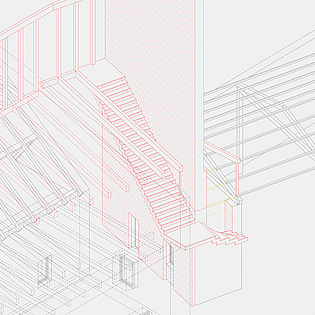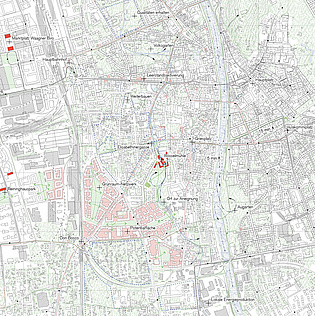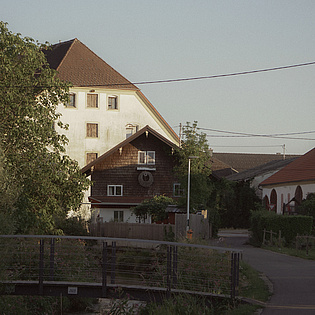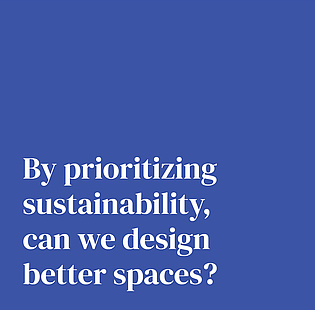The Graz Architecture Diploma Awards (GAD Awards) are bestowed annually by the Faculty of Architecture to honor outstanding diploma projects from the previous academic year.
This year, the accompanying program for the GAD Awards ceremony was supplemented by “Three Standpoints of Architecture,” in which the members of this year’s jury — Ulrike Tinnacher, Paul Preissner, and Pier Paolo Tamburelli — presented their personal approach to the discipline and discussed current projects in their architectural research and practice. The concept for the exhibition was developed by the Institute of Spatial Design under the supervision of Alex Lehnerer.
Beatrice Raith, Anna-Maria Jäger, Marie- Theres Schwaighofer, Theresa Schleinitz, Valentin Moser, Angelika Hinterbrandner, Nera Džanić, and Dennis Baumgartner are the winners of the GAD Awards 2023. The prizewinning projects show how the processes of building-on, cooperative district development, a vision of housing based on realpolitik, the recultivation of vacant buildings in the countryside, housing suitable for women, and building with papiermâché can succeed. The awards celebration was held on October 19, 2023, in HS I in Alte Technik.
1. Prize
The first prize, endowed by the regional government of Styria, Department 16 Transport and Building Construction, went to Beatrice Raith for her project “Die wachsenden Häuser von Wetzelsdorf” (The Growing Houses of Wetzelsdorf ). The subject of her master’s thesis, supervised by Alex Lehnerer at the Institute of Spatial Design, is the situational creation of architecture: always-building-on. This process is illustrated using the example of a single-family home in the Wetzelsdorf district of Graz and presented in the form of four booklets with four stories. This year’s jury, consisting of Ulrike Tinnacher (tinnacher.studio, Vienna), Paul Preissner (Paul Preissner Architects, Chicago), and Pier Paolo Tamburelli (baukuh, Milan / TU Vienna), found the project “impressive in a deeper, conceptual way, because it did something programmatically ambitious, namely, working with many situationally constructed moments of a building. These moments are not sequential and could have been executed in any order; nevertheless, they add up to create a different relationship to the original building and do so in a free-spirited way that is somewhat reminiscent of action art.” (Paul Preissner)
2.Prize
The second-place prize of the GAD Awards was shared by Anna-Maria Jäger, Marie-Theres Schwaighofer, and Theresa Schleinitz for her project. Supervised by Aglaée Degros at the Institute of Urbanism, this diploma thesis by Anna-Maria Jäger and Marie-Theres Schwaighofer addresses the theme of equal-opportunity, generative urban (district) development in the context of the Gries district of Graz, which has been influenced by immigration, and specifically with the future development of the Rösselmühle, which has been defunct since 2014. The work sketches the transformation of the mill into a communityoriented project distinguished by high density of use and diverse green and open spaces in the spirit of a fairer and socially diverse city. The jury praised its approach to a “very complicated problem from different perspectives” and “precise urbanplanning and architectural interventions” (Pier Paolo Tamburelli).
Theresa Schleinitz’s master’s thesis, which was also awarded the second-place prize, was written at the Institute of Construction and Design Principles and was supervised by Eva Sollgruber. Her thesis calls for a renovation of existing architectural and social structures that explicitly addresses the reality of the lives of women and sets the goal of a safer, more accessible, and more diverse world for all people. Specifically, an existing building is redesigned as a house for women that, as an alternative to monofunctional building types, can increase the visibility of urgent feminist demands of architecture. A quote from the jury’s statement: “The project creates a new feminist domestic space that is not monoprogrammed but instead flexible and diverse with regard to what happens within it, with parts of the existing building removed or rebuilt. It is at once gentle and aggressive.” (Paul Preissner)
Hollomey Travel Prize
This year’s Hollomey Travel Prize has been awarded to Valentin Moser, whose master’s thesis, supervised by Andreas Lechner at the Institute of Construction and Design Principles, concerns vacant buildings in the countryside and how to recultivate them by involving local parties. “The project received a prize not just because it concerns vacant buildings in the countryside but also because it overlays hybrid uses that broaden them. With a bold new building and a sensitive approach to the existing fabric, it results in a remarkable and diverse ensemble.” (Ulrike Tinnacher)
Tschom Housing Prize
Angelika Hinterbrandner’s project on Alexander Klein’s innovative design method from the 1930s was awarded the Tschom Housing Prize. Her master’s thesis, supervised by Daniel Gethmann at the Institute of Architectural Theory, Art History, and Cultural Studies, lays the cornerstone for a reinterpretation of Klein’s approaches to a new standard in housing construction by reflecting on the socioeconomic conditions under which Klein’s approach was developed. According to the jury, the theoretical and historical research of the project make an important contribution to the field of housing and show “the potential that can lie in rediscovering some past experiences.” (Pier Paolo Tamburelli)
Awards for resource-conserving and climate-just architecture
The prize that the Chamber of Civil Engineers of Styria and Carinthia awards to recognize resource-conserving and climate-just architecture has been conferred on Nera Džanić’s project “Papiermâché: From Paper to Sustainable Architecture Material.” Her master’s thesis, supervised by Milena Stavrić at the Institute of Architecture and Media, studies the production of a new, paper-based composite material in environmentally friendly and sustainable processes to create biodegradable and reusable products. The resulting composite materials shows immense potential to become and aesthetically and functionally relevant part of interior design. “It is a very focused project that examines in detail paper as a product and its sustainable use as an architectural material. We recognize this project’s experimental and unconventional approach.” (Ulrike Tinnacher)
Recognition award
A nonmonetary prize in the form of a Moroccan carpet donated by Gebhart Blazek (Berber Arts) was awarded to Dennis Baumgartner as a special recognition. His thesis, supervised by Andreas Lechner at the Institute of Construction and Design Principles, concerns the Haunoldmühle in the Steyr Valley and examines vacant buildings through the lens of cultural and art studies and historical preservation. According to the jury, the typological conversion into an event location was designed “in a freethinking sense, in that it not only romanticizes the decrepitude of the historical project, but also produces entirely new objects within the building, which, on the one hand, retain the decay in its originality and, on the other, preserve the imprecision of the historical structure.” (Paul Preissner)










































































